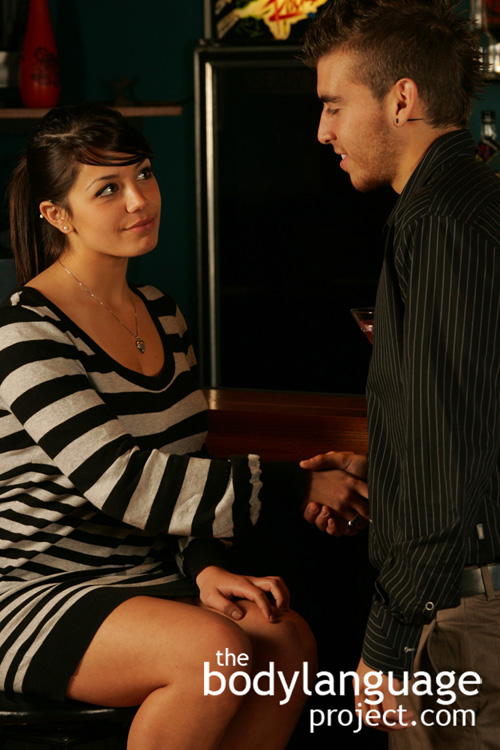Body Language of The European Leg Cross
 Cue: European Leg Cross
Cue: European Leg Cross
Synonym(s): Knee-Knee Leg Cross.
Description: A sitting position where the leg is crossed neatly over the other in a longitudinal fashion.
In One Sentence: The European leg cross is a sign that a person is in control of themselves and wishes for others to see him or her as sophisticated and proper.
How To Use it: Men should use the European leg cross when they wish to show others that they are well mannered. It falls in direct contrast to spreading the legs which is overt and dominant. Keeping the legs together shows others that you wish to be careful about being offensive. Therefore, use the leg cross during business context, in academic circles, and amongst friends and relatives. The leg cross shows others that you do not wish to be offensive or vie for power and dominance.
Women are best advised to use this sitting posture most of the time, especially when wearing dresses or skirts as it produces an element of chasteness. This posture falls in direct contrast to having the legs wide open. In recent times, women have been permitted to carry more masculine postures including legs spread, however, women of sexual maturity should cross their legs one over the other to appear more feminine, in control, and to create and protect their social sexual value by keeping it out of the public view.
Weddings, which is becoming one rare time when women dress up, is proving to be particularly troublesome for women as it related to the leg cross posture. Not being accustomed to crossing the legs and being in feminine attire including dresses and skirts, often leads to undergarment flashing. Women should be mindful of their attire with respect to their posture and how they will be perceived by others. While not all women seek to be treated lady-like, if they do, they should use lady-like comportment.
Context: General.
Verbal Translation: “By crossing my legs neatly together I’m showing everyone that I’m proper, controlled and cerebral.”
Variant: See Leg Crossing and Leg Crossing Direction, Loving Circle Leg Cross.
Cue In Action: At the meeting of scholars, the professor neatly crossed his legs while addressing a large crowd.
Meaning and/or Motivation: The European leg cross is the most common seating position in European, Asian and British cultures. It signifies dignity, intelligence, and desire to be proper. This is the case for both men and women. It contrasts directly with legs spread or the Figure-Four Leg Cross which is more dominant and overt since it puts the crotch on display.
Women will often be seen in the European leg cross as the absence of a penis makes it more comfortable, but men who wish to show superiority will also sit in this fashion to be more proper. Women in skirts are almost forced to sit in the European leg cross to prevent others from seeing up their skirts but will also reveal additional thigh creating a degree of sexual appeal. Men residing in the West commonly sit in the figure four postures where the ankle rests on the opposite knee. This is a more dominant and authoritative due to the crotch display.
Cue Cluster: The European leg cross is often coupled with leaning back and being slightly more detached, rather than wanting and leaning forward. This is usually controlled gesticulation, a calm demeanor, stern and less animated facial expressions.
Body Language Category: Arrogance or arrogant body language, Authoritative body language, Comfort body language, Confident, Dominant body language, Nonthreatening body language, Closed body language.
Resources:
Adams, E.S., Mesterton-Gibbons, M., 1995. The cost of threat displays and the stability of deceptive communication. J. Theor. Biol. 175, 405–421.
Allen, Jill; Sarah J. Gervais and Jessi L. Smith. Sit Big to Eat Big: The Interaction of Body Posture and Body Concern on Restrained Eating. Psychology of Women Quarterly 2013. 37(3): 325-336. DOI: 10.1177/0361684313476477pwq.sagepub.com
http://bodylanguageproject.com/articles/sit-big-to-eat-big-how-constrictive-postures-reduce-food-consumption/
Arnette, S. L., & Pettijohn, T. F., II. (2012). The effects of posture on self-perceived leadership. International Journal of Business and Social Science, 3, 8–13.
Bohns, Vanessa K. and Scott S. Wiltermuth. It Hurts When I Do This (Or You Do That): Posture And Pain tolerance. Journal of Experimental Social Psychology. 2012. 48: 341-345.
http://bodylanguageproject.com/articles/dominant-and-submissive-postures-affects-more-than-public-perception-it-also-affects-felt-pain-and-physical-strength/
Briñol, P., Petty, R. E., & Wagner, B. (2009). Body posture effects on self-evaluation: A self-validation approach. European Journal of Social Psychology, 39, 1053–1064.
Burgoon, J. K., Johnson, M. L., & Koch, P. T. (1998). The nature and measurement of interpersonal dominance. Communication Monographs, 65, 308–335.
Carney, D. R., Hall, J. A., & LeBeau, L. S. (2005). Beliefs about the nonverbal expression of social power. Journal of Nonverbal Behavior, 29, 105–123.
Carney, Dana R.; Amy J.C. Cuddy; Andy J. Yap. Power Posing: Brief Nonverbal Displays Affect Neuroendocrine Levels and Risk Tolerance. Psychological Science, 2010; 21 (10): 1363-1368.
http://bodylanguageproject.com/articles/benefits-power-posing-high-stakes-performance/
Cesario, J., & McDonald, M. M. (2013). Bodies in context: Power poses as a computation of action possibility. Social Cognition, 31, 260–274.
Cuddy, Amy J.C., Caroline A. Wilmuth, and Dana R. Carney. The Benefit of Power Posing Before a High-Stakes Social Evaluation. Harvard Business School Working Paper, No. 13-027, September 2012.
http://bodylanguageproject.com/articles/benefits-power-posing-high-stakes-performance/
Clifford, Ruth. Development of masturbation in college women. Archives of Sexual Behavior. 1978. 7(6): 559-573.
de Bruijn G. From masturbation to orgasm with a partner: how some women bridge the gap–and why others don’t. J Sex Marital Ther. 1982. 8(2):151-67.
Graves, James R. ; Robinson, John D. Osipow, Samuel H. (editor). Proxemic behavior as a function of inconsistent verbal and nonverbal messages. Journal of Counseling Psychology. 1976. 23(4): 333-338.
Ellis, L. (1994). The high and the mighty among man and beast: How universal is the relationship between height (or body size) and social status? In L. Ellis (Ed.). Social stratification and socioeconomic inequality (Vol. 2, pp. 93–111). Westport, CT: Praeger Publishers.
Gorkan Ahmetoglu, Viren Swami. Do Women Prefer “Nice Guys?” The Effect Of Male Dominance Behavior On Women’s Ratings. Social Behavior And Personality, 2012; 40(4), 667-672.
http://bodylanguageproject.com/articles/how-to-significantly-increase-male-attractiveness-with-simple-body-language-nice-guys-finish-last-once-again/
Fischer, Julia; Peter Fischer; Birte Englich; Nilüfer Aydin and Dieter Frey. Empower My Decisions: The Effects of Power Gestures on Confirmatory Information Processing. Journal of Experimental Social Psychology. 2011. 47: 1146-1154.
http://bodylanguageproject.com/articles/downside-power-posing-body-language-looking-power-posing-action-study/
http://bodylanguageproject.com/articles/benefits-power-posing-high-stakes-performance/
Huang, L., Galinsky, A. D., Gruenfeld, D. H., & Guillory, L. E. (2011). Powerful postures versus powerful roles: Which is the proximate correlate of thought and behavior? Psychological Science, 22, 95–102.
Hill, Clara E. ; Stephany, Alicia Harmon, Lenore W. (editor). Relation of Nonverbal Behavior to Client Reactions. Journal of Counseling Psychology. 1990. 37(1): 22-26.
Hewes, Gordon (1957). “The Anthropology of Posture.” In Scientific American (Vol. 196), pp. 122-32.
Kimbrell, G. Relationship of the upright agonistic posture in the foot shock situation to dominance-submission in male C57BL/6 mice. Psychonomic Science. 1969. 16(3): 167-168.
Kinsey, A. C., Pomeroy, W. B., Martin, C. E., and Gebhard, P. H. (1953). Sexual Behavior in the Human Female, Saunders, Philadelphia.
Laird, J. D., & Lacasse, K. (2014). Bodily influences on emotional feelings: Accumulating evidence and extensions of William James’s theory of emotion. Emotion Review, 6, 27–34.
Lee, E. H., & Schnall, S. (2014). The influence of social power on weight perception. Journal of Experimental Psychology: General, 143, 1719–1725.
Mehrabian, A., Friar, J., 1969. Encoding of attitude by a seated communicator via posture and position cues. Journal of Consulting and Clinical Psychology 33: 330–336.
Mehrabian, Albert Deese, James (editor). Significance of posture and position in the communication of attitude and status relationships. Psychological Bulletin. 1969. 71(5): 359-372
Michael Reiβ. Leg-crossing: Incidence and inheritance. Neuropsychologia. 1994. 32(6): 747-750.
Marsh, Abigail A; Henry H. Yu; Julia C. Schechter and R. J. R. Blair. Larger than Life: Humans’ Nonverbal Status Cues Alter Perceived Size. PLoS ONE. 2009. 4(5): e5707. doi:10.1371/journal.pone.0005707.
http://bodylanguageproject.com/articles/large-life-nonverbal-dominance-affects-perception-size/
Morris, Desmond (1994). Bodytalk: The Meaning of Human Gestures (New York: Crown Publishers).
Michalak, J., Mischnat, J., & Teismann, T. (2014). Sitting posture makes a difference: Embodiment effects on depressive memory bias. Clinical Psychology & Psychotherapy, 21, 519–524.
Minvaleev, R. S., Nozdrachev, A. D., Kir’yanova, V. V., & Ivanov, A. I. (2004). Postural influences on the hormone level in healthy subjects: I. The cobra posture and steroid hormones. Human Physiology, 30, 452–456.
Meier, B. P., Hauser, D. J., Robinson, M. D., Friesen, C. K., & Schjeldahl, K. (2007b). What’s ‘up’ with God?: Vertical space as a representation of the divine. Journal of Personality and Social Psychology, 93, 699–710.
Meier, B. P., & Robinson, M. D. (2004). Why the sunny side is up: Associations between affect and vertical position. Psychological Science, 15, 243–247.
Meier, B. P., & Robinson, M. D. (2005). The metaphorical representation of affect. Metaphor and Symbol, 21, 239–257.
Melamed, T. (1992). Personality correlates of physical height. Personality and Individual Differences, 13, 1349–1350.
Middleton, W. C., &Moffett, D. C. (1940). The relation of height and weight measurements to intelligence and to dominance-submission among a group of college freshmen. Research Quarterly of the American Association for Health, Physical Education, and Recreation, 11, 53–59.
Montepare, J. M. (1995). The impact of variations in height on young children’s impressions of men and women. Journal of Nonverbal Behavior, 19, 31–47.
Meier, B.P., Robinson, M.D., & Caven, A.J. (in press). Why a big mac is a good mac: Associations between affect and size. Basic and Applied Social Psychology.
Matsumura, Shuichi ; Hayden, Thomas J. When should signals of submission be given?–A game theory model. Journal of Theoretical Biology. 2006. 240(3): 425-433.
Nair, S., Sagar, M., Sollers, J., III, Consedine, N., & Broadbent, E. (2014). Do slumped and upright postures affect stress responses? A randomized trial. Health Psychology. Advance online publication. doi:10.1037/hea0000146
Park, Lora E.; Lindsey Streamer; Li Huang and Adam D. Galinsky. Stand Tall, But Don’t Put Your Feet Up: Universal and Culturally-Specific Effects of Expansive Postures On Power. Journal of Experimental Social Psychology. 2013; 49: 965–971.
http://bodylanguageproject.com/articles/are-expansive-postures-of-power-universal-or-cultural/
Pease, Barbara and Allan Pease. 2006. The Definitive Book of Body Language Hardcover. Bantam.
Pinar, Rukiye ; Ataalkin, Sıddıka ; Watson, Roger. The effect of crossing legs on blood pressure in hypertensive patients. Journal of Clinical Nursing. 2010. 19(9-10): 1284-1288.
Park, Yongnam ; Bae, Youngsook. Comparison of Postures According to Sitting Time with the Leg Crossed. Journal of Physical Therapy Science. 2014. 26(11): 1749-1752.
Peters. M. Footedness: asymmetries in foot preference and skill and neuropsychological assessment of foot movement. Psycho/. Bull. 103, 179 192, 1988.
Plato. C. C., Fox, K. M. and Gakruto, R. M. Measures of lateral functional dominance: Foot preference. digital interlocking, arm-folding and fool overlapping. Human Biology. 1985. 57: 327-334.
Prieto, A. G., & Robbins, M. C. (1975). Perceptions of height and self-esteem. Perceptual and Motor Skills, 40, 395–398.
Robinson, Michael D. ; Zabelina, Darya L. ; Ode, Scott ; Moeller, Sara K. The vertical nature of dominance-submission: Individual differences in vertical attention. Journal of Research in Personality. 2008. 42(4): 933-948.
Reiss M. Leg-crossing: incidence and inheritance. Neuropsychologia. 1994. 32(6):747-50.
Ranehill, Eva; Anna Dreber; Magnus Johannesson; Susanne Leiberg; Sunhae Sul and Roberto A. Weber. Assessing the Robustness of Power Posing: No Effect on Hormones and Risk Tolerance in a Large Sample of Men and Women. Psychological Science, March, 2015. doi: 10.1177/0956797614553946 http://bodylanguageproject.com/articles/power-posing-no-effect-hormones-amy-cuddy-wrong/
Riskind, J. H. (1984). They stoop to conquer: Guiding and selfregulatory functions of physical posture after success and failure. Journal of Personality and Social Psychology, 47, 479–493.
Riskind, J. H., & Gotay, C. C. (1982). Physical posture: Could it have regulatory or feedback effects on motivation and emotion? Motivation and Emotion, 6, 273–298.
Stepper, S., & Strack, F. (1993). Proprioceptive determinants of emotional and nonemotional feelings. Journal of Personality and Social Psychology, 64, 211–220.
Strelan, P., Weick, M., & Vasiljevic, M. (2013). Power and revenge. British Journal of Social Psychology, 53, 521–540.
Smith-hanen, Sandra S. Osipow, Samuel H. (editor). Effects of nonverbal behaviors on judged levels of counselor warmth and empathy. Journal of Counseling Psychology. 1977. 24(2): 87-91.
Schubert, T. W. (2005). Your highness: Vertical positions as perceptual symbols of power. Journal of Personality and Social Psychology, 89, 1–21.
Schwartz, B., Tesser, A., & Powell, E. (1982). Dominance cues in nonverbal behavior. Social Psychology Quarterly, 45, 114–120.
Stepper, S., & Strack, F. (1993). Proprioceptive determinants of emotional and nonemotional feelings. Journal of Personality and Social Psychology, 64, 211–220.
Schenkel, Rudolf. Submission: Its Features and Function in the Wolf and Dog. American Zoologist. 1967. 7(2): 319-329.
Tracy, J. L., & Robins, R. W. (2004). Show your pride: Evidence for a discrete emotion expression. Psychological Science, 15, 194–197.
Tiedens, Larissa Z. and Alison R. Fragale. Power Moves: Complementarity in Dominant and Submissive Nonverbal Behavior. Journal of Personality and Social Psychology. 2003, 84(3): 558–568.
http://bodylanguageproject.com/articles/power-posing-no-effect-hormones-amy-cuddy-wrong/
Van Velthoven, Michelle H M M T ; Thien, Theo ; Holewijn, Suzanne ; Van Der Wilt, Gert Jan ; Deinum, Jaap. The effect of crossing legs on blood pressure. Journal of hypertension. 2010. 28(7): 1591-2.
Vrugt, Anneke, and Ada Kerkstra (1984). “Sex Differences in Nonverbal Communication.” In Semiotica (50-1/2), pp. 1-41.
Welker, K. M., Oberleitner, D. E., Cain, S., & Carré, J. M. (2013). Upright and left out: Posture moderates the effects of social exclusion on mood and threats to basic needs. European Journal of Social Psychology, 43, 355–361.
Yap, Andy J. Abbie S. Wazlawek, Brian J. Lucas, Amy J. C. Cuddy, Dana R. Carney. The Ergonomics of Dishonesty: The Effect of Incidental Posture on Stealing, Cheating, and Traffic Violations, 24(11); 2281-2289.
http://bodylanguageproject.com/articles/body-posture-physical-environment-determine-feelings-and-behaviour-study/






